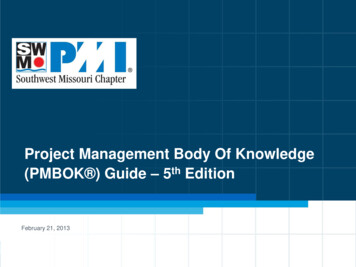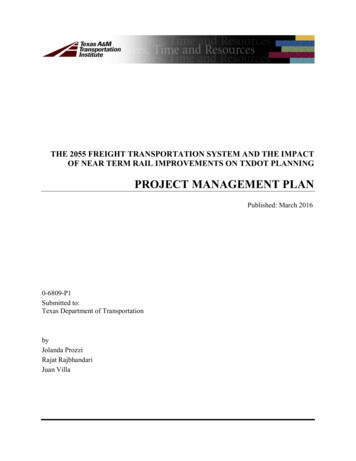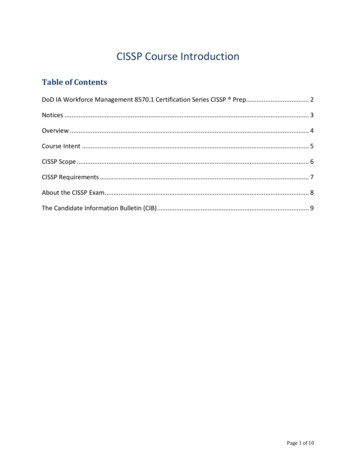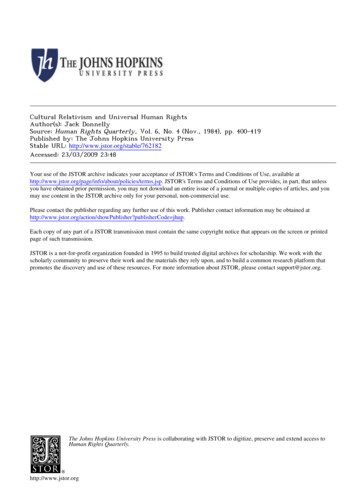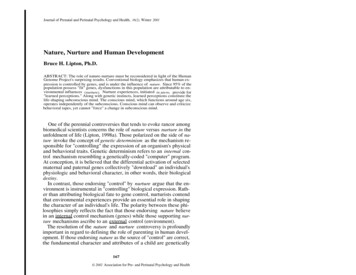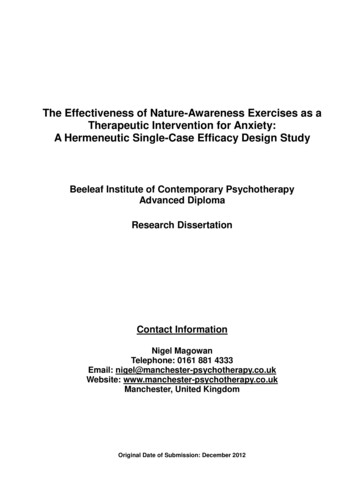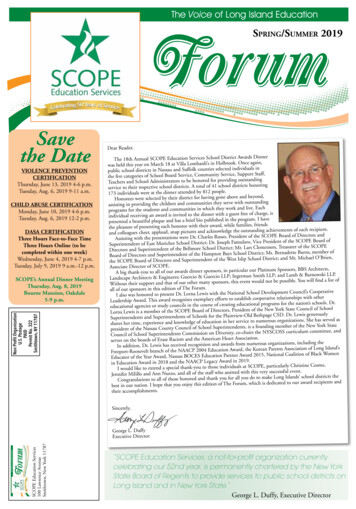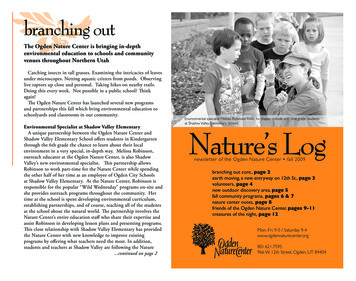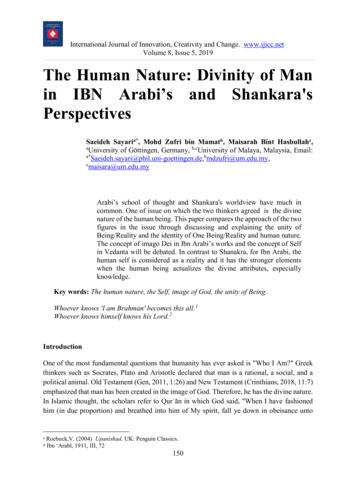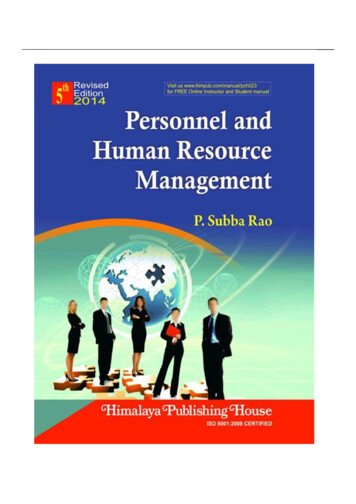
Transcription
Nature and Scope of Human Resource Management1
2Personnel and Human Resource ManagementPERSONNEL ANDHUMAN RESOURCEMANAGEMENTP. SUBBA RAOPro Vice-Chancellor (ASA),University of Papua New Guinea,Papua New Guinea (Australia).Formerly: Professor and Dean,Faculty of Commerce and Management,Sri Krishnadevaraya University,Anantapur-515 003 (AP), India.E-mail: pulapas@rediffmail.comP. Venkatram Tej KumarBi Developer, Venture Foods Ltd., CA, USA.MUMBAI NEW DELHI NAGPUR BENGALURU HYDERABAD CHENNAI PUNE LUCKNOW AHMEDABAD ERNAKULAM BHUBANESWAR INDORE KOLKATA GUWAHATI
Nature and Scope of Human Resource Management 3AuthorStored in a retrieval system, or transmitted in any form or by any means, electronic, mechanical, photocopying, recording and/or otherwise without the prior written permission of the publisher.MILLENNIUM EDITIONSECOND REVISED AND ENLARGED EDITIONTHIRD REVISED AND ENLARGED IONEDITIONEDITIONFOURTH REVISED AND ENLARGED EDITIONFIFTH REVISED EDITION:::::20062007200820092014Published by:Mrs. Meena Pandey for Himalaya Publishing House Pvt. Ltd.,“Ramdoot”, Dr. Bhalerao Marg, Girgaon, Mumbai - 400 004.Phone: 022-23860170/23863863, Fax: 022-23877178E-mail: himpub@vsnl.com; Website: www.himpub.comBranch Offices:New Delhi:“Pooja Apartments”, 4-B, Murari Lal Street, Ansari Road, Darya Ganj,New Delhi - 110 002. Phone: 011-23270392, 23278631; Fax: 011-23256286Nagpur:Kundanlal Chandak Industrial Estate, Ghat Road, Nagpur - 440 018.Phone: 0712-2738731, 3296733; Telefax: 0712-2721216Bengaluru:No. 16/1 (Old 12/1), 1st Floor, Next to Hotel Highlands, Madhava Nagar,Race Course Road, Bengaluru - 560 001. Phone: 080-22286611, 22385461, 4113 8821, 22281541Hyderabad:No. 3-4-184, Lingampally, Besides Raghavendra Swamy Matham, Kachiguda,Hyderabad - 500 027. Phone: 040-27560041, 27550139Chennai:8/2 Madley 2nd street, T. Nagar, Chennai - 600 017. Mobile: 09320490962Pune:First Floor, "Laksha" Apartment, No. 527, Mehunpura, Shaniwarpeth (Near Prabhat Theatre),Pune - 411 030. Phone: 020-24496323/24496333; Mobile: 09370579333Lucknow:House No 731, Shekhupura Colony, Near B.D. Convent School, Aliganj,Lucknow - 226 022. Phone: 0522-4012353; Mobile: 09307501549Ahmedabad:114, “SHAIL”, 1st Floor, Opp. Madhu Sudan House, C.G. Road, Navrang Pura,Ahmedabad - 380 009. Phone: 079-26560126; Mobile: 09377088847Ernakulam:39/176 (New No: 60/251) 1st Floor, Karikkamuri Road, Ernakulam, Kochi – 682011.Phone: 0484-2378012, 2378016; Mobile: 09387122121Bhubaneswar :5 Station Square, Bhubaneswar - 751 001 (Odisha). Phone: 0674-2532129, Mobile: 09338746007Indore:Kesardeep Avenue Extension, 73, Narayan Bagh, Flat No. 302, IIIrd Floor,Near Humpty Dumpty School, Indore - 452 007 (M.P.). Mobile: 09303399304Kolkata:108/4, Beliaghata Main Road, Near ID Hospital, Opp. SBI Bank, Kolkata - 700 010, Phone: 033-32449649, Mobile: 7439040301Guwahati:House No. 15, Behind Pragjyotish College, Near Sharma Printing Press, P.O. Bharalumukh,Guwahati - 781009, (Assam). Mobile: 09883055590, 08486355289, 7439040301DTP by:SunandaPrinted at:Geetanjali Press Pvt. Ltd., Nagpur. On behalf of HPH.
4Personnel and Human Resource ManagementToThe LotusFeet ofGoddessSri Sarada Devi
Nature and Scope of Human Resource Management5Preface to the Fifth EditionIntensified competition among domestic private and public sector companies and multinational companies consequentupon globalisation, economic boom and recessionary conditions along with the changed demographic factors like increasein women employees, aging populations, shortage of talented employees and adapted mindset and attitude of the peoplebrought paradigm shifts in organisational and competitive strategies. Different competitive strategies need distinctivetechniques of human resource management. In fact, effective strategy implementation depends on the strategic humanresource management. Thus, appropriate human resource management assumes greater significance after globalisationand consequent economic boom and recession. Now, most of the organisations recognised the emerging vitality of appropriatehuman resource management based on organisational strategies and placed human resource issues at strategic level inthe organisational hierarchy.The overwhelming response from the Students, Lecturers, Professors and Heads of various Business Schools andHuman Resource Management Departments/Divisions of various universities in India, Papua New Guinea and other countriesto the earlier editions of my book on “Personnel and Human Resource Management” inspired me and my publishers tobring this revised edition. In fact, the students’ community across India, Papua New Guinea and other developing countriespersuaded me to revise this book as soon as possible in view of the student-friendly approach, wide coverage, comprehensivetreatment and lucid language presentation followed in the earlier editions.This book is endowed with latest information, developments and data on human resource issues and decision-makingin multiple modes like updated text, boxes, figures, tables, exhibits and cases.Many students particularly from Executive MBA students and HRM students of the School of Business Administration,UPNG, Papua New Guinea and students from other universities across the developing countries provided online feedbackas well as persuaded me to bring this edition. I immensely thank them for their support and encouragement. I am grateful tothe teachers who provided to me the comments for upgrading the book. Particularly, I would like to express my gratitude toProf. Albert C. Mellam, Vice-Chancellor, University of Papua New Guinea, Papua New Guinea and Prof. M. GangadharaRao, my teacher and the former Vice-Chancellor, GITAM University.Mr. Niraj Pandey, Mrs. Ujjwala Pandey, Mr. Anuj Pandey, Mr. Vijay Pandey, and Ms. Nimisha of Himalaya PublishingHouse Pvt. Ltd. have provided immense support in bringing this revised edition. I thank all of them immensely.My wife Mrs. Pulapa Rama Devi, was put in inconvenience during the period of writing this book. I express my gratitudeto her.I request the students, teachers and other readers to write to me with their comments and suggestions via e-mail.Port Moresby, Papua New Guineath12 April 2014Pulapa Subba Raopulapas@rediffmail.com
6Personnel and Human Resource ManagementPreface to the Fourth EditionGlobalisation and information technology along with changed priorities and attributed value additions of businesshouses and individual employees brought significant changes in the human resource policies and practices. In addition,several changes have taken place in the practices of human resource management in Indian organisations due to the recenteconomic recision across the globe. In addition, the overwhelming response of the students and faculty to the third editionof this book inspired me to revise and bring out the fourth revised edition.The current edition is characterised by the additions in the following chapters: Chapter 2: Environmental Analysis Chapter 3: Team Analysis and Flexible Job Environment Chapter 8: Strategic Approach to Performance Management Chapter 9: Audiovisual Methods and E-Training Chapter 16: Sixth Pay Commission Chapter 25: Employers’ Organisations Chapter 26: Employee Counselling and Mentoring Chapter 28: Recent Industrial Conflicts Chapter 29: Co-determination Chapter 33: Employer’s Brand, Competency Mapping, HR Matrix, BPO-HR IssuesMany students particularly from Business Schools in India and Papua New Guinea provided me an opportunity torevise this book. I immensely thank them for their support and encouragement. I am grateful to the teachers who providedto me the comments for upgrading the book. Particularly, I would like to express my gratitude to the University of PapuaNew Guinea (UPNG) and Sri Krishnadevaraya University, India for providing me an opportunity to revise this book. Myspecial thanks are due to Prof. Albert C. Mellam, Executive Dean, School of Business Administration, University of PapuaNew Guinea, Papua New Guinea and Prof M. Gangadhara Rao, my teacher and the Vice-Chancellor, GITAM University,India.Mr. Niraj Pandey, Mrs. Ujjwala Pandey, Mr. Anuj Pandey, Mr. Vijay Pandey, Mr. Krishna Poojari, Mr. S.K. Patil,Mrs. Ivy Lewis, Mr. F. Lewis, Ms. Poopathi, Ms. Nimisha and Ms. Kalpana of Himalaya Publishing House have providedimmense support in bringing this revised edition. I thank all of them immensely.My wife Mrs. Pulapa Rama Devi, daughter Hima Bindu and son Tej Kumar were put in inconvenience during the periodof revising this book. I express my gratitude to them.I request the students, teachers and other readers to write to me with their comments and suggestions via e-mail.Port Moresby, Papua New Guineast21 December 2008– Pulapa Subba Raopulapas@rediffmail.com
Nature and Scope of Human Resource Management7ContentsChapter 1Nature and Scope of Human Resource Management1 - 27Meaning of Human Resources Meaning and Definition of HRM Functions of HRM —Managerial Functions — Operative Functions Nature of HRM Scope of HRM Importance ofHRM Role of HRM Systems Approach to Study HRM Objectives of HRM OrganisationDesign and Live and Staff HR Manager — Role — Qualifications and Qualities — Careers in HRM Evolution, Origin and Development of HRM Questions for Discussion Chapter 2Human Resource Management: Environment and Strategies28 - 43Business Environment Factors: Internal and External Environment Factors — Why Study HRMEnvironment — Strategic Human Resource Management Introduction W hat is Strategy? What is Strategic Management? Strategic Management Process Corporate Level Strategies —Strategic Human Resource Issues Organisational and Human Resource Strategies — Mergerand Acquisition Strategies SBU Level Strategies Questions for Discussion Chapter 3Job Analysis, Team Analysis and Flexible Job Enviornment44 - 66Job Design — Approaches — Options: Job Rotation — Job Enlargement — Job Band width —Job Enrichment — Team work Job Analysis — Need — Team Analysis — Process — Information Job Description — Characteristics — Contents — Steps Job Specification — Information Usesof Job Analysis Team Design and Team Analysis Job Sharing Telecommuting Ergonomics Employee Empowerment Questions for Discussion. Chapter 4Human Resources Planning67 - 81Strategic planning-Basis for HRP Meaning and Objectives of HRP Benefits of HRP FactorsAffecting HRP Process of HRP — Analysing the corporate and unit level strategies — Demandforecasting — Supply forecasting — Estimating the net human resource requirements — Actionplan for redeployment, retrenchment etc. — Forecast the future supply from all sources — Actionplan for Outsourcing, Recruitment etc. — Plan to modify organisational plan Problems of HRP Recent Trends in HRP Questions for Discussion Chapter 5Recruitment82 - 95Definition and objectives of recruitment Stragegic management and recruitment — Companystrategies and recruitment strategies — Recruitment policy — Centralised and decentralisedrecruitment Searching for prospective Employees/Sources of Recruitment — Traditional sources— Modern sources Stimulate the candidates to apply for a job — Traditional Techniquies —Modern Techniques Factors affecting recruitment Applicants' pool Assessment of RecruitmentProgramme Questions for Discussion Chapter 6Selection, Placement and Induction96 - 114Meaning and Definition — Essentials of Selection Procedure — Role of Selection Procedure —Organisation for Selection Selection Procedure — Application Form — Written Examination —Preliminary Interview — Psychological Tests — Final Interview — Medical Examination — ReferenceChecks — Line Manager’s Decision — Job Offer — Employment Placement — Problems —Making Effective Induction — Objectives — Advantages Questions for Discussion Chapter 7Human Resource DevelopmentSignificance of HRD Concept of HRD — Features of HRD Scope of HRD Need for HRDHRD objectives HRD Framework — Tecniques of HRD — Outcomes of HRD Functions ofHRD Manager HRD Tasks of Line Manager Attributes of an HRD Manager Questions forDiscussion 115 - 131
8Chapter 8Personnel and Human Resource ManagementPerformance Appraisal132 - 151Strategic Management and Performance Appraisal Meaning, Need and Purposes AppraisersMethods of Performance Appraisal — Traditional Methods: Graphic Rating Scales — RankingMethod — Paired Comparison Method — Forced Distribution Method — Checklist Methods (Simple,weighted and critical incident) — Essay/Free Form Appraisal — Group Appraisal — ConfidentialReports Modern Methods: Behaviourally Anchored Rating Scales — Assessment Centre —Human Resource Accounting — MBO — Behaviour Observation Scale — Psychological Appraisals Result Method, Productivity Measures, The Balance Scorecard Managerial Appraisal Uses ofPerformance Appraisal Problems of Performance Appraisal Recent Developments LegalIssues in Performance Management Questions for Discussion Chapter 9Employee Training152 - 169Meaning Assessment of training needs Training methods On-the-Job Methods: JobRotation, Coaching, Job Instruction, Step-by-Step, Committee Assignments, Intership Off-the-JobMethods: Vestibule Training, Role Playing, Lecture, Conference/Discussion, ProgrammedInstruction Training procedure Training Within Industry Advantages of training Evaluation oftraining programme On-Line Training, Special Aspects of Training-Team Training Questions forDiscussion Chapter 10Management Development170 - 179Introduction Objectives of, Need for and Principles of Management Development Methods ofManagement Development On-the-Job Methods: Coaching, Job Rotation, Under Study, MultipleManagement Off-the-Job Methods: Case Method, Incident, Role Playing, In Basket,Business Game, Sensitivity Training, Simulation, Grid Training, Conferences, Lectures Trainingand Development for International Assignments Selection of Techniques Electronic MDPs Evaluation of MDPs Questions for Discussion Chapter 11Career Planning and Development180 - 185Career Planning — Meaning — Need for — Process Succession Planning Career Development— Steps — Career Development Actions — Advantages Recent Developments Questions forDiscussion Chapter 12Promotion, Transfer and Demotion186 - 194Promotions — Meaning — Types — Purposes — Bases(Merit, Seniority, Merit-Cum-Seniority) —Benefits — Problems Transfer — Meaning — Reasons — Types Demotions — Meaning —Reasons — Principles Questions for Discussion Chapter 13Absenteeism and Labour Turnover195 - 200Absenteeism — Meaning — Types — Calculation of absenteeism rate — Causes — Categories— Measures to Minimise absenteeism Labour Trunover — Meaning — Types — Computation Effects of External Mobility Controlling External Mobility Questions for Discussion Chapter 14Management of Change and Development201 - 209Technology and Change Managing Change Resistance to Change Approaches toOrganisational Change Organisation Development — Meaning — Characteristics — Values —Objectives Organisational Culture Questions for Discussion Chapter 15Job EvalutationMeaning/Definitions of Job Evaluation Objectives, Principles, Procedure Methods/Techniquesof Job Evaluation — Non-Quantitative (Ranking, Job Classification) — Quantitative (Points Rating,Factors Comparision) Problems of Job Evaluation Merit Rating Questions for Discussion 210 - 221
Nature and Scope of Human Resource ManagementChapter 16Wage and Salary Administration9222 - 243Definitions and Concepts Objectives of Wages and Salary Administration Factors AffectingWage/Salary Levels W age Boards and Pay Commissions W age Incentives Profit Sharing Bonus Managerial Compensation Questions for Discussion Chapter 17Social Security and Welfare244 - 255Social Security — Meaning — Evolution — International Standards — Social Security Legislationsin India — Integrated Social Security Need for Extending Benefits Objectives of Benefits Typesof Social Secuurity and Welfare Programmes — Payment for Time Not Worked — Employee Security— Safety and Health — Welfare and Recreational Facilities — Old Age and Retirement Benefits —Non-Monetary Benefits — Stock-Option Scheme Questions for Discussion Chapter 18Motivation and Job Satisfaction256 - 264Definitions of Motivation Objectives of Motivation Theories of Motivation — Maslow's Theory ofHierarchy of Needs — Herzberg's Two Factor Theory — Vroom's Expectancy Theory of Motivation —Alderfer's ERG Theory — The Porter and Lawler Model Expectancy Theory — Equity Theory of WorkMotivation Job Satisfaction — Meaning — Factors of Job Satisfaction Questions for Discussion Chapter 19Morale265 - 271Definitions Importance of Morale Individual and Group Morale Factors Affecting MoraleMeasurement of Morale Morale and Productivity Warning Signs of Low Morale Maintenanceof Morale Improvement of Morale Questions for Discussion Chapter 20Communication272 - 292Meaning Purposes of Communication in HRM Importance Fundamentals of CommunicationFunctions Process of Commuincation MIS and Information Technology Oral, Written andNon-Verbal Communication Communication Channels and Network InterpersonalCommunication Listening Organisational Commuincation Informal Communication/Grapevine Barriers to Communication How to make Communication Effective? Ten Commandments ofEffective Communication Questions for Discussion Chapter 21Leadership293 - 313Leadership — Effectiveness of Leaders — Development of Individuals — Building the Teams —Make the Vision Tangible W hat is Leadership? — Mutual Influence of Leader and Follower —Leader's Power — Leader Vs. Manager Leadership Theories: Group and Exchange Theories ofsLeadership — Behavioural Theories — Ohio State Studies — University of Michigan Studies —Scandinavian Studies — Continuous Theory of Leadership — Leader Participation Model — Herseyand Blanchard's Life Cycle (or) Situational Approach — Modern Theories of Leadership: CharismaticTheory — Transformational Leadership Theory Leadership Styles — Styles based on TraditionalTheories — Leadership Styles Based on Modern Theories Qualities/Approaches of OutstandingLeaders Leadership Skills Questions for Discussion Chapter 22Work Environment, Industrial Accidents, Safety and Health314 - 326Meaning Fatigue — Implications — Symptoms — Causes — Types Monotony BoredomMeasurement Industrial Accidents — Injury — Causes of Employee Safety: Safety Committees Industrial Health: Importance — Occupational Hazards and Risks Questions for Discussion Chapter 23Indian Labour MarketMeaning Salient Features of Indian Labour Market A Profile of Indian Managers A Profile ofIndian Workers Organised and Unorganised Labour Markets in India Bonded Labour ChildLabour Questions for Discussion 327 - 333
10Chapter 24Personnel and Human Resource ManagementIndustrial Relations334 - 339Meaning of Industrial Relations Characteristics of Industrial Relations Factors of IndustrialRelations — The Three Actors of Industrial Relations — Importance of Harmonious IndustrialRelations — Objectives of Industrial Relations Functions of Industrial Relations Code of IndustrialRelations Conditions for Congenial Industrial Relations Questions for Discussion Chapter 25Trade Unions and Employer’s Association340 - 357Trade unions: Meaing — Why do workers join unions Functions and Role of Unios: A ITUC,INTUC, HMS, BMS, HMP Unoins structure — Trade Union (Amendment) Act, 2001 Problems ofTrade Unions Why decline in unions after globalisation? Measures to strengthers Trade UnionMovement in India Employment Organisation: Introduction — Public Sector Employers Organisation— Objectives and Function Chapter 26Grievance and Discipline, Counselling and Mentoring358 - 373Grievance Procedure — Meaning/Definition — Need for Grievance Procedure — The Causes ofGrievances — Pre-requisities of a Grievance Procedure — Grievance Procedure DisciplinaryProcedure — Need for Disciplinary Procedure — Meaning — Aspects of Disciplinary Procedure —Objectives of Disciplinary Procedure — Red-Hot Stove Rule — Causes of Indiscipline — DomesticEnquiry — Disciplinary Procedure — Types of Punishment Employee Counselling Concept,types, objectives - mentoring: Meaning, Functions Questions for Discussion Chapter 27Collective Bargaining374 - 379Definitions of Collective Bargaining Characteristics of Collective Bargaining Importance ofCollective Bargaining Essential Conditions for the Collective Bargaining Functions of CollectiveBargaining Collective Bargaining Process Collective Bargaining in India Recommendationsof NCL Questions for Discussion Chapter 28Industrial Conflicts380 - 388Definitions of a Dispute/Conflicts Causes of Industrial Conflicts Types of Industrial Conflicts —Man-days Lost Due to Strikes — Lockouts — Mandays lost due to Lockouts Consequnences ofIndustrial Conflicts Prevention of Industrial Conflicts Settlement of Conflicts Questions forDiscussion Chapter 29Participative Management, Quality Circles and Empowerment389 - 402Co-determination — Autonomous Work Group — Socio-Technical System Workers' Participationin Management — Definition — Objectives — Forms:W orks Committees, Joint ManagementCouncils, Joint Councils, Shop Councils — WPM Scheme of 1975 — Performance Evaluation —Reasons for Limited Success — Suggestions for Success Quality Circles — Meaning —Objectives — Organisational Structure — Benefits of Quality Circles — Problems of Quality Circle Co-Determination Autonomous Work Group Industrial Democracy Socio-Technical System Suggestion Scheme Empowerment Meaning Important Similarities Questions for Discussion Chapter 30Work Life: Quality and Related Issues403 - 410Quality of Work Life — Meaning — Specific Issues in QWL — QWL and Productivity ErgonomicsWork Place Violence Sexual Harasment, Alcoholism and Drug Abuse Questions forDiscussion Chapter 31Total Quality and Human Resources ManagementMeaning and Definition Principles and Core Concepts of TQMQuality HR Strategies Questions for Discussion 411 - 418 HRD and TQM The Total
Nature and Scope of Human Resource ManagementChapter 32Human Resource Records, Accounting, Audit and Research11419 - 429Human Resource Records — Meaning and types of records — Importance of records — Essentialsof good record — Purpose — Reports Human Resource Audit — Objectives — Need — Areas Human Resource Research — Characteristics — Objectives — Need — Approaches — Process Chapter 33Recent Tecniques in HRM Chapter 34430 - 446Employer’s Brand Competency Mapping HR Matrix Attitudes, Emotions Employee ReferralsBusiness Process Outsourcing: HR Issues Right Size of Workforce Dual Career GroupsFlexitime Knowledge Management Virtual Organisation and HRm Learning OrganisationEthics in Human Resource Mangement447 - 453Meaning of Ethics Ethics in: Job Design Human Resource Planning Recruitment andSelection Training and Development Career Planning and Development Employee Turnover Wage and Salary Administration Questions for Discussion Chapter 35Internatinal Human Resource Management454 - 459Introduction Global Recruitment Global Selection Approach Expatrictes and InternationalAdjustment Cross-Cultural Training Compensation W omen in International Business Questions for Discussion Chapter 36E-Human Resources Management Introduction E-business Neural Networks — Aspects of E-HRM E-Job Design and AnalysisE-Human Resource Planning E-Recruitment E-Selection E-Performance ManagementE-Training and Development E-Composation Management E-HR Records E-HR InformationE-HR Audit Questions for DiscussionAppendix - I Method of Case Analysis 460 - 464What is a Case? 465 - 466How to Analyse a Case?Appendix - II Cases467 - 471(1) Low Salary for Nationals and High Salary for Expatriates for the Same Job Halting the Wingsof the Flights(2) Telecommuting: Empty Cubicals vs. Beyond Job Design?(3) Down Size or Up Size: Compliance to Strategy or Adjust the Strategy?(4) Decide Now, But Do it Tomorrow!(5) Treating the Employees as Human Beings and Cost on HR as Strategic Investment?(6) An Ethical Dilemma(7) Collective Bargaining vs. Individual Bargaining(8) Do you Redress the Grievances of Employee’s Wife Too?Subject Index472 - 476
12Personnel and Human Resource ManagementNATURE AND SCOPE OFHUMAN RESOURCEMANAGEMENT1CHAPTERINTRODUCTIONInformation technology (IT) — a wonderful creation of man – brought significant shifts in our day-to-daylife. Indian software professionals made significant strides in the information technology industry of USA.Employees of Rourkela Steel Plant turned the loss-making unit into a profit-making company. Similarly,employees of TISCO, acquired core competencies for their company which was affected by dumping of steelfrom China. Most of the public sector companies like Hindustan Machine Tools Ltd. (HMT), and HindustanCables Ltd., (HCL) became sick. Thus, the people make or mar an organisation. How to induce the people tomake an organisation but not to mar it? Every company or organisation is deeply interested in having ananswer to this question. The answer to this question centred around the following areas: Getting the people who can make an organisation. Enabling those people to acquire required capabilities to make a successful organisation. Motivating them to contribute their resources continuously for running the organisation successfully.We need to know an important concept, i.e., human resources. People with required skills to make anorganisation are generally referred to as human resources.Meaning of Human ResourcesAccording to Leon C. Megginson, the term human resources (HR) can be thought of as “the total knowledge,skills, creative abilities, talents and aptitudes of an organisation’s workforce, as well as the value, attitudes andbeliefs of the individuals involved.” The term human resources can also be explained in the sense that it is aresource like any natural resource. It does mean that the management can get and use the skill, knowledge,ability etc., through the development of skills, tapping and utilising them again and again by developing apositive attitude among employees. The aspect of ‘attitude’ among the human resources aspects gainedsignificance alongwith globalisation (See Box 1.1).Box 1.1: Positive Attitudes Make An OrganisationThe process of liberalisation, globalisation and the consequent competition made the business organisations torealise that the persons with positive attitude have self-commitment and motivation and are loyal to the organisation. Theysee the positive aspects and serve the customers. Organisations having employees with positive attitude have becomemarket leaders. Hence, it is suggested that: Having the right attitude elevates your attitude. Try to maintain a positive outlook and strive to adopt an attitude of gratitude. Right attitude improves your aptitude.
Nature and Scope of Human Resource Management13Managing of these human resources deals with the above areas and also provides an answer to thequestion referred above. Now, we shall discuss the meaning of human resources management (HRM) andother areas:Meaning and Definition of HRMIn simple sense, human resources management means employing people, developing their resources,utilising, maintaining and compensating their services in tune with the job and organisational requirements witha view to contribute to the goals of the organisation, individual and the society.Michael J. Jucius defined Personnel Management as “the field of management which has to do withplanning, organising, directing and controlling the functions of procuring, developing, maintaining and utilising alabour force, such that the —(a) Objectives for which the company is established are attained economically and effectively,(b) Objectives of all levels of personnel are served to the highest possible degree, and(c) Objectives of society are duly considered and served.”According to Pulapa Subba Rao, human resources management (HRM) is managing (planning, organising,directing and controlling) the functions of employing, developing, compensating and utilising human resources,resulting in the creation and development of human and industrial relations which would shape the futurepolicies and practices of human resource management, with a view to contribute proportionately (due to them)to the organisational, individual and social goals.Having discussed the meaning of HRM, now we shall discuss the similar terms of HRM.Similar Terms: Various terms are used to denote human resources management. These terms are:labour management, labour administration, personnel management, personnel administration, human capitalmanagement, human asset management, employment administration, employee-employer relations, unionmanagement relations, industrial relations and the like.Under the labour management concept, the employees are treated just like a commodity which can bepurchased, used and thrown. Therefore, it deals with employment, wages and firing. The concept of industrialrelations deals with relations among employees, trade unions, employers and the government. Therefore, itcovers trade unions, disputes, grievances, discipline, collective bargaining and participative management.The latest term in this direction is Human Resources Development (HRD). Some view that HRM and HRDare one and the same. In fact, some organisations changed their personnel management department asHuman Resources Management Department, while other organisations changed them as Human ResourcesDevelopment Department. But HRD is the developmental aspect of HRM. Thus,
2 Personnel and Human Resource Management PERSONNEL AND HUMAN RESOURCE MANAGEMENT P. SUBBA RAO Pro Vice-Chancellor (ASA), University of Papua New Guinea, Papua New Guinea (Australia). Formerly: Professor and Dean, Faculty of Commerce and Management, Sri Krishnadevaraya University, Anantapur-515 003 (AP), India. E-mail: pulapas@rediffmail.com
